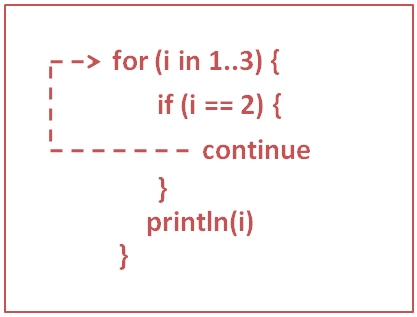

'Continue' statement is used with the loops to skip a few lines of code below it.
Let us make it simple with the below example.
Say we have a 'for loop' that prints the numbers from 1, 2 and 3.
fun main() {
for (i in 1..3) {
println(i)
}
}
Now, let's say, we don't want the number '2' to be printed. We just want to print '1' and '3' as output.
Let us rewrite the program using 'continue' statement.
fun main() {
for (i in 1..3) {
if (i == 2) {
continue
}
println(i)
}
}
Now, if you see the output, '2' is omitted from the output, printing only '1' and '3' as output.
Let us see it in detail :
So, we have a 'for loop' that prints the numbers from 1 to 3.
for (i in 1..3) {
if (i == 2) {
continue
}
println(i)
}
And the Iteration starts,
In the 1st Iteration, '1' is taken and stored in the variable 'i'.

So, in the next line, we check if the value of the variable 'i' is '2' or not.
if (i == 2) {
continue
}
In this case the value of 'i' is '1'. So, we do not enter the 'if block' and come to the print statement.
Printing the value of 'i'.
Then we start the second Iteration of 'for loop'.
In the 2nd Iteration, '2' is taken and stored in the variable 'i'.

So, in the next line, we check if the value of the variable 'i' is '2' or not.
if (i == 2) {
continue
}
In this case the value of 'i' is '2'. So, we enter the 'if block' and come to the continue statement.
And what the 'continue' statement does is, ends the current Iteration of the 'for loop' and starts the next Iteration.

And the value of 'i' i.e. '2' is not printed.
And the 3rd Iteration starts.
Similarly, in the 3rd Iteration, '3' is taken and stored in the variable 'i'.

Same way, in the next line, we check if the value of the variable 'i' is '2' or not.
if (i == 2) {
continue
}
In this case the value of 'i' is '3'. So, we do not enter the 'if block' and come to the print statement.
Printing the value of 'i'.
With this we end the execution of 'for loop'.